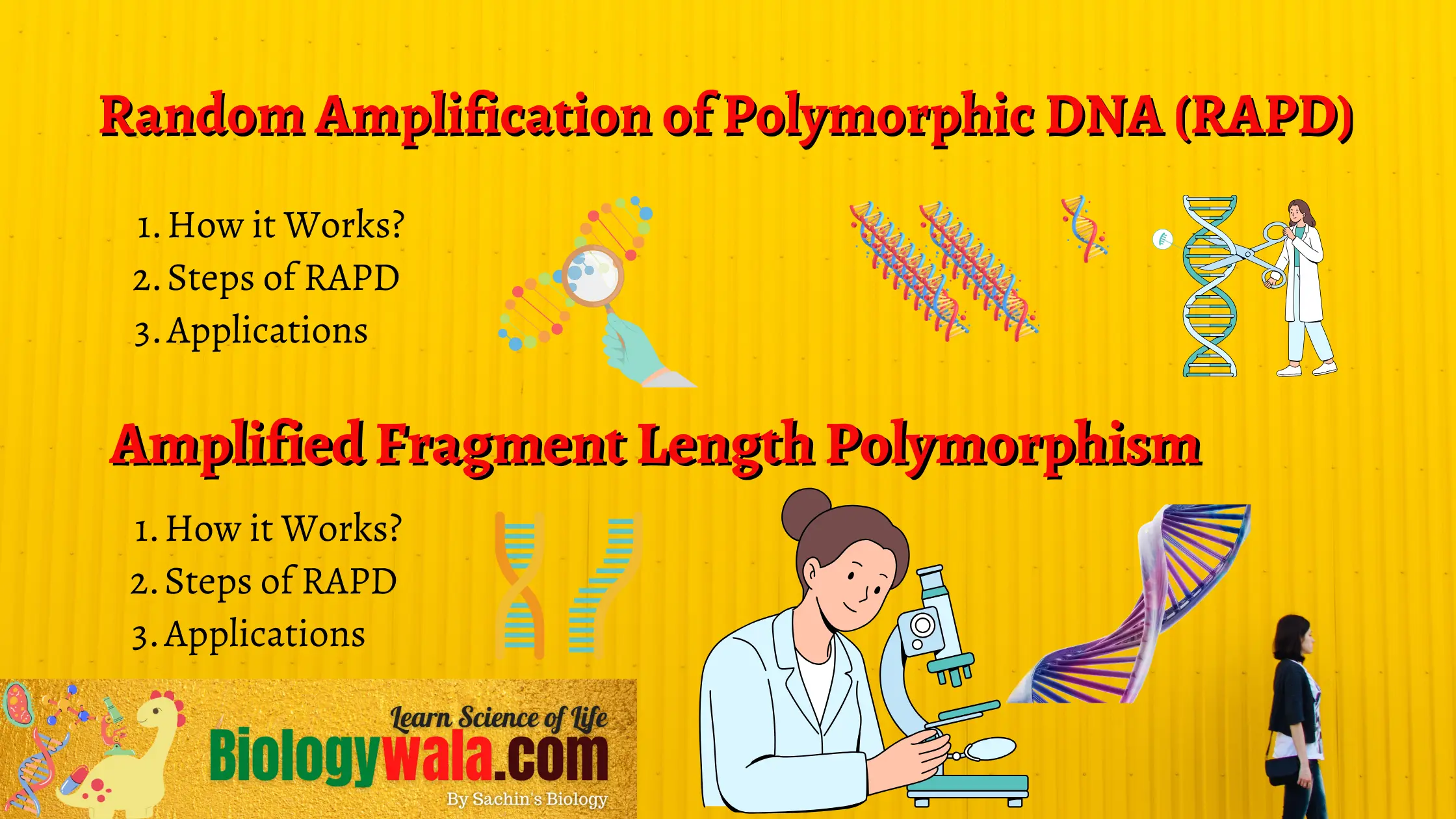Random Amplification of Polymorphic DNA (RAPD)

Random Amplification of Polymorphic DNA (RAPD):
RAPD stands for Random Amplification of Polymorphic DNA. RAPD DNA markers are decamer
DNA fragments. RAPD is a type of PCR reaction, Segments amplified are Random. No knowledge of DNA sequence required. Hence a popular method. In recent years, RAPD is used to Characterize, & Trace, the phylogeny of diverse plant & animal species. Identical 10-merprimer will or will not amplify a segment of DNA, depending on positions that are complementary to the primer sequence.
How it Works?
The principle of RAPD is that a single, short oligonucleotide primer, which binds to many
different loci, is used to amplify random sequences from a complex DNA template. This means
that the amplified fragment generated by PCR depends on the length and size of both the primer
and the target genome. These amplified products (of up to 3.0 kb) are usually separated on
agarose gels (1.5-2.0%) and visualised by ethidium bromide staining.Nucleotide variation
between different sets of template DNAs will result in the presence or absence of bands because
of changes in the priming sites. Recently, sequence characterised amplified regions (SCARS) analysis of RAPD polymorphisms showed that one cause is chromosomal rearrangements such as insertions/deletions.
In order for PCR to occur:
1) Primers should be identified in a specific orientation, such as pointing to each other.
2) They should anneal within a reasonable distance of each other.
Essential components of RAPD:
1. Buffer (containing Mg ++ ) – usually high Mg^ ++ concentrations are used lowering annealing
stringency
2.Template DNA
3.1 short primer (10 bases) not known to anneal to any specific part of the template DNA
4.dNTPs
5.Taq DNA Polymerase (or another thermally stable DNA polymerase)
RAPD involves following steps:-
1.The selected species DNA has been isolated.
-quality influences the outcome of the PCR
-high molecular weight. No impure template.less amount of RNA
- An excessive of the selected decaoligonucleotide has been added.
-10 base primer for PCR, only 1 primer per reaction
-Short primer bind randomly on the chromosome. - This mixture is kept in a PCR equipment and is subjected to repeated cycles of DNA
denaturation- renaturation-DNA replication. - During this process, the decaoligonucleotide pairs up with a homologous sequence that is
present in different regions of DNA. - DNA replication extend the decaoligonucleotide and copy the sequence continuous with the
sequence with which the selected oligonucleotide has paired. - The repeated cycles of denaturation-renaturation- DNA replication will amplify this sequence
of DNA. - Only those regions of the genome that have a sequence complementary to the
decaoligonucleotide at both ends will be amplified. - The DNA is subjected to gel electrophoresis after several cycles of amplification.
-Initial denaturation at 94° C for 10 min.
-Denaturation at 94°C for 1 min.
-Annealing at 37 – 45° C for 1 min.
-Extension at 72° C for 1 min.
-Final extension at 72 °C for 10 min.
-Cooling at 4°C. - The amplified DNA will form a distinct band. It is detected by ethidium bromide staining and
- visible fluorescence’s under U.V. light.
Applications:
- Genetic diversity/polymorphism,
- Germplasm characterization,
- Genetic structure of populations,
- hybrid purity,
- Genome mapping
- Developing genetic markers linked to a trait in question,
- Population and evolutionary genetics,
- plant and animal breeding,
- Animal-plant-microbe interactions,
- Pesticide/herbicide resistance.
Amplified Fragment Length Polymorphism: AFLP
AFLP is a technique based on the principle of selectively amplifying the subset of restriction
fragments from a complex mixture of DNA fragments obtained after the digestion of genomic
DNA with restriction endonucleases.
First described by Vos and Zabeau in 1993.It Involves the use of RFLP and PCR
techniques.Amplify the same gene from different individual. It is powerful approach to detect
polymorphism.
Steps:
- Digestion
- Adaptor ligation
- Amplification
- Electrophoresis
Digestion
- Different restriction endonucleases are used in Digestion.
•One is four-base cutter, Msel - The other one is six base cutter, EcoRl
Adaptor ligation - Two different adaptors (short double-stranded DNA with sticky ends) are ligated to the digested
fragments.
•One adaptor will complement to Msel cut end and the other will complement to the EcoRI cut
end.
Amplification - Selected fragments are amplified and separated by polyacrylamide gel electrophoresis.
•By repeating this second amplification with other primer pairs a different subset of the genome
is amplified.
Electrophoresis
•Polyacrylamide gel is used for separating DNA bands. Normally, 30-100 DNA bands can be
detected by AFLP on polyacrylamide gel.
Advantages of AFLP:
- No need for the known sequence in the genome
- High reproducibility
- Many loci are simultaneously analyzed
- By changing the selective nucleotide, different part of the genome can be analyzed.
- Whole genome analysis is possible (theoretically) .
The only disadvantage is that it is a complex procedure.
Applications: - The AFLP technology has the capability to detect various polymorphisms in different genomic
regions simultaneously. - AFLP has become widely used for the identification of genetic variation in strains or closely
related species of plants, fungi, animals, and bacteria. - The AFLP technology has been used in criminal and paternity tests, also to determine slight
differences within populations, and in linkage studies to generate maps for quantitative trait locus
(QTL) analysis.
You will also like:
Download the Free Book of Plant Physiology by Taiz and Zieger 6th edition
[Download] Top 5 Books for Molecular Biology: Basic to Advance
Regulation of gene in Prokaryotes
[Download] Free Molecular Biology of Cancer PDF Book 4th Edi.
Join SACHIN’S BIOLOGY on Instagram or Facebook to receive timely updates and important notes about exams directly on your mobile device. Connect with Mr. Sachin Chavan, the founder of Sachin’s Biology and author of biologywala.com, who holds an M.Sc., NET JRF (AIR 21), and GATE qualifications. With SACHIN’S BIOLOGY, you can have a direct conversation with a knowledgeable and experienced.

![[Download] Free Stryer Biochemistry PDF Book 8th Edition: 3 [Download] Free Stryer Biochemistry PDF Book 8th Edition:](https://biologywala.com/wp-content/uploads/2021/08/0001-5200758680_20210802_080744_0000-520x245.png)
